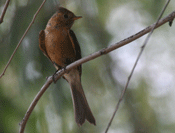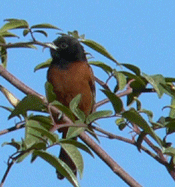 |
 |
|||||||||||||||||||||
|
||||||||||||||||||||||
AZFO Annual Meeting Expeditions
List of Field Expeditions
Registration for Mini-Expeditions is required: On-line Registration Form
Friday, September 18th
South Fork of the Little Colorado River & Grasslands Wildlife Area
Leader: Chris Benesh
Spaces available: 10
The South Fork of the Little Colorado River west of Eagar has been a source of ornithological interest over the decades, containing one of the few breeding populations of Gray Catbirds in the state, along with historical local breeding of Veeries and American Redstarts. American Dippers have also nested here and surrounding pinyon-juniper woodland and ponderosa pine forest attract sought-after species such as Pinyon Jays and Juniper Titmice. Additionally, this area has harbored an astounding array of rarities in the past, including White-eared and Magnificent Hummingbirds, Least Flycatcher, Yellow-throated Vireo, Brown Thrasher, Golden-winged, Black-throated Blue, Blackpoll, Kentucky, Worm-eating, and Swainson’s Warblers. Come explore what species pop up here on their southbound migration! In addition, we may check out nearby Grasslands Wildlife Area where raptors, sparrows, meadowlarks, and even Mountain Plovers are possible.
Lyman Lake State Park / St. Johns
Leader: Charles Babbitt
Spaces available: 10
Fall migration brings the exciting potential for rare shorebirds, gulls, and terns, giving birders a great opportunity to challenge their identification skills. Lyman Lake, a reservoir along the Little Colorado River south of St. Johns, has in the past produced such notable species as Sanderling, Short-billed Dowitcher, Caspian, Common, Black, and Least Terns, and Sabine’s Gulls. Locally occurring populations of Scaled and introduced California Quail are also a possibility, along with surprise vagrants such as Prairie Warbler.
Alchesay Hatchery / North Fork of the White River (White Mountain Apache Reservation)
Leader: Eric Hough
Spaces available: 10
Come explore the riparian and pine-oak forest habitat of this very under-birded area of the state. Located below the Mogollon Rim along the North Fork of the White River, sub-Colorado Plateau species such as Common Black-Hawk, Hutton’s Vireo, and Bridled Titmouse occur. Other notable species that have been found here include Montezuma and Gambel’s Quail, American Dipper, Dusky-capped Flycatcher, Eastern Bluebird, and White-throated Sparrow. Participants willing to drive their own vehicle and carpool others will need to obtain a $10 day-use recreational permit from the tribe (participants will be notified with more details ahead of the trip).
White Mountain Lake / Bill’s Lake
Leader: Mary Williams
Spaces available: 10
This trip will give birders access to the private White Mountain and Bill’s Lakes north of Show Low where usually only residents are allowed. Ospreys, Bald Eagles, Double-crested Cormorants, and herons have nested here and local populations of Phainopeplas and Canyon Towhees are present. Fall migrant waterfowl, shorebirds, and passerines are possible on the lakes and surrounding vegetation. Clay-colored Sparrows, Dickcissels, and Painted Buntings are species that could potentially occur in weed and sunflower patches here, as they have at similar locations in the White Mountains region during fall migration.
Sunday, September 20th
Sheep’s Crossing / West Fork-Mt. Baldy Trail
Leader: Troy Corman
Spaces available: 10
The Sheep’s Crossing area along the West Fork of the Little Colorado River is a traditional spot for state birders to look for American Dippers and Gray Jays, but a hike up the West Fork-Mt. Baldy Trail can also yield other high-elevation species such as Dusky Grouse, Northern Goshawk, American Three-toed Woodpecker, Golden-crowned Kinglets, and Pine Grosbeaks. We will also look for mixed flocks of migrating passerines moving through the surrounding spruce-fir-aspen forest and along the riparian vegetation lining the river. Come join us for a hike through the beautiful high country of the White Mountains!
Wenima Wildlife Area / Becker Lake
Leader: Kurt Radamaker
Spaces available: 10
Wenima Wildlife Area along the Little Colorado River just north of Springerville provides great riparian birding within a scenic canyon containing petroglyphs and other historical sites. Montezuma, Scaled, and introduced California Quail, Crissal Thrasher, Canyon Towhee, and Rufous-crowned Sparrow can be locally found, along with mixed flocks of flycatchers, warblers, and sparrows migrating along the river. Past vagrants to this location have included Groove-billed Ani, Common Ground-Dove, Vermilion Flycatcher, Thick-billed and Eastern Kingbirds, White-eyed Vireo, Prothonotary, Magnolia, and Worm-eating Warblers, American Tree and Clay-colored Sparrows, Dickcissel, and Bobolink. Afterwards, we will check out nearby Becker Lake Wildlife Area, which has also had its share of great rarities including Neotropic Cormorant, Parasitic Jaeger, Red Phalarope, Sabine’s Gull, Least Flycatcher, Philadelphia and Red-eyed Vireos, Magnolia, Blackpoll, and Mourning Warblers, Clay-colored Sparrow, Dickcissel, and Rusty Blackbird.
Greer reservoirs & creeks
Leader: Anne Pellegrini
Spaces available: 15
The tiny resort town of Greer is situated near the Little Colorado River, several tributary creeks, and three dammed reservoirs. Despite the surrounding mountainsides being burned during the 2011 Wallow Fire, this location is still a productive birding spot. The burned area has attracted an influx of American Three-toed Woodpeckers, the reservoirs have potential to attract rare gulls, terns, and jaegers in September, and the willow-alder riparian thickets along the creeks hold potential for rare migrant passerines, along with lingering summer resident Gray Catbirds. Magnificent Hummingbirds have also been reported at feeders at adjacent lodges and restaurants in the past.
Big & Crescent Lakes
Leaders: David Vander Pluym and Lauren Harter
Spaces available: 10
Two large reservoirs surrounded by scenic high elevation grassland and spruce-fir-aspen and ponderosa pine forest, Big and Crescent Lakes southwest of Eagar are always worth checking during migration for possible rare waterfowl, gulls, terns, and jaegers. September is within the peak migration period for Sabine’s Gulls in Arizona, with multiple records from Big Lake. In addition, we may find shorebirds along the lakeshore, along with grassland and forest residents, including possible Montezuma Quail and Gray Jays. Come join us for some fall migration lakeside birding in the scenic White Mountains!
East Fork of the White River (White Mountain Apache Reservation)
Leader: Eric Hough
Spaces available: 10
This trip will explore a very under-birded area of the southwestern side of the White Mountains, along the East Fork of the White River. Riparian and sub-Colorado Plateau species such as Zone-tailed and Common Black-Hawks, Mexican Jay, Bridled Titmouse, and Summer Tanager are possible at the lower elevations, with Dusky Grouse and American Dipper possible at higher elevations. As the Indian Route 55 climbs in elevation through varied forest types, we will encounter different suites of forest bird species. Mixed flocks of migrant passerines moving along high elevation ridgelines and riparian areas may yield rarities. *Participants willing to drive their vehicles and carpool others will need to obtain a $10 day-use recreation permit from the tribe (participants will be notified with more details ahead of the trip).
Registration for Mini-Expeditions is required: On-line Registration Form
Field Trip Coordinator:
Eric Hough
![]() :expeditions@azfo.org
:expeditions@azfo.org


Lapland Longspur
Evergreen Turf Farm
Photo by Virginia Fairchild

Photo by Don Sejkora
Updated Sunday
|
|
©2005
|
HOME | | | REPORT SIGHTINGS | | | PHOTOS | | | BIRDING | | | JOURNAL | | | ABOUT US | | | COUNTY BIRDS | | | AZ BIRD COMMITTEE | | | EVENTS | | | LINKS |